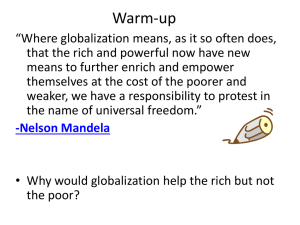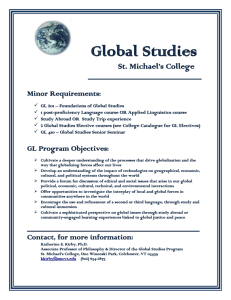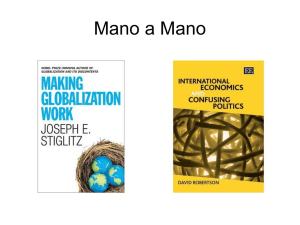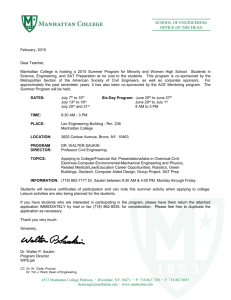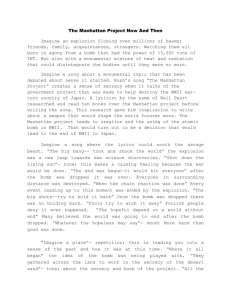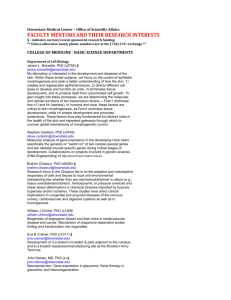New York in the World Report
advertisement
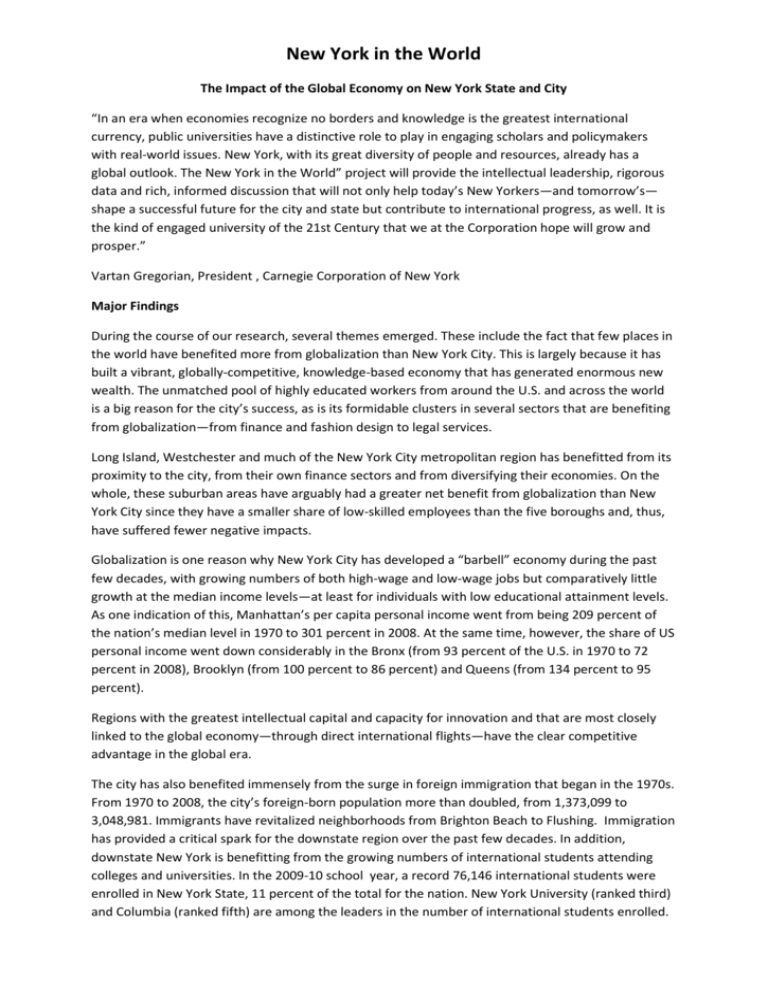
New York in the World The Impact of the Global Economy on New York State and City “In an era when economies recognize no borders and knowledge is the greatest international currency, public universities have a distinctive role to play in engaging scholars and policymakers with real-world issues. New York, with its great diversity of people and resources, already has a global outlook. The New York in the World” project will provide the intellectual leadership, rigorous data and rich, informed discussion that will not only help today’s New Yorkers—and tomorrow’s— shape a successful future for the city and state but contribute to international progress, as well. It is the kind of engaged university of the 21st Century that we at the Corporation hope will grow and prosper.” Vartan Gregorian, President , Carnegie Corporation of New York Major Findings During the course of our research, several themes emerged. These include the fact that few places in the world have benefited more from globalization than New York City. This is largely because it has built a vibrant, globally-competitive, knowledge-based economy that has generated enormous new wealth. The unmatched pool of highly educated workers from around the U.S. and across the world is a big reason for the city’s success, as is its formidable clusters in several sectors that are benefiting from globalization—from finance and fashion design to legal services. Long Island, Westchester and much of the New York City metropolitan region has benefitted from its proximity to the city, from their own finance sectors and from diversifying their economies. On the whole, these suburban areas have arguably had a greater net benefit from globalization than New York City since they have a smaller share of low-skilled employees than the five boroughs and, thus, have suffered fewer negative impacts. Globalization is one reason why New York City has developed a “barbell” economy during the past few decades, with growing numbers of both high-wage and low-wage jobs but comparatively little growth at the median income levels—at least for individuals with low educational attainment levels. As one indication of this, Manhattan’s per capita personal income went from being 209 percent of the nation’s median level in 1970 to 301 percent in 2008. At the same time, however, the share of US personal income went down considerably in the Bronx (from 93 percent of the U.S. in 1970 to 72 percent in 2008), Brooklyn (from 100 percent to 86 percent) and Queens (from 134 percent to 95 percent). Regions with the greatest intellectual capital and capacity for innovation and that are most closely linked to the global economy—through direct international flights—have the clear competitive advantage in the global era. The city has also benefited immensely from the surge in foreign immigration that began in the 1970s. From 1970 to 2008, the city’s foreign-born population more than doubled, from 1,373,099 to 3,048,981. Immigrants have revitalized neighborhoods from Brighton Beach to Flushing. Immigration has provided a critical spark for the downstate region over the past few decades. In addition, downstate New York is benefitting from the growing numbers of international students attending colleges and universities. In the 2009-10 school year, a record 76,146 international students were enrolled in New York State, 11 percent of the total for the nation. New York University (ranked third) and Columbia (ranked fifth) are among the leaders in the number of international students enrolled. New York City has realized enormous benefits from globalization. New York, along with London, is one of the world’s two pre-eminent markets for fine art. Wealthy art investors fly to Manhattan from all over the world to attend auctions at Sotheby’s, Christie’s and Phillips De Pury. The industry’s economic impact is substantial; Sotheby’s, alone, has 500 employees in New York. The city’s renowned hospitals consistently attract wealthy patients from around the globe for surgeries, treatments and other procedures. In 2010, New York City hosted a record 9.7 million foreign tourists, a 43 percent increase from both 2000 and 2005. Sixty-percent of the visitors to the Museum of Modern Art are foreign nationals. In addition to so many globally-competitive industry clusters, New York City has benefited from its enormous regional labor market. It supplies workers with almost any skill set needed in the global marketplace, from creating innovative new financial instruments to conserving Renaissance paintings. The competitive importance of New York’s talent advantages were recognized in the 2010 Cities of Opportunity rankings by PricewaterhouseCoopers and the Partnership for New York City, which gave the city the highest scores among 21 cities worldwide in measurements of intellectual capital such as the percent of population with higher education and share of top 500 universities. In 2009, 59 percent of Manhattan residents at least 25 or older held at least a bachelor’s degree, a 17 point increase since 1990. Another factor is that cities that are easily accessed from around the world have a tremendous advantage. Advances in communications technology might have been expected to lead to the dispersal of New York City’s corporate management, finance and professional services functions. But the opposite has occurred. In a highly dispersed global economy, more than ever business people need a central, globally accessible place to meet face-to-face. John F. Kennedy and Newark airports together host 94 different airlines, more than any other U.S. city, and have non-stop flights to 128 international destinations. While New York City has 44.7 percent of all private sector jobs in the state, it has a disproportionately large share of the state’s jobs in high-end service sectors that are still competitive in today’s global economy, including the securities industry (with 89.1 percent of jobs in the state), motion picture and sound recording (84.9 percent) advertising (82.3 percent), publishing (65.7 percent) and legal services (63.0 percent). Meanwhile, the impact of manufacturing jobs losses is being ameliorated by the expansion of the area’s existing globally-connected, high-tech sector. From 2000 to 2008, employment in professional and technical services increased by more than 5,000, which according to the State Labor Department was primarily due to growth in research and development-related employment. A global knowledge economy puts a premium on talent, innovation and creativity. Globalization opportunities and challenges for New York City New York’s physical infrastructure—airports, highways, mass transit and rail—are in need of repair and in some instances need to be expanded. And New York City faces competitive challenges to its position as world financial capital. Insurance Insurance remains an important sector for New York, but the city has lost ground to international competitors in recent decades. The industry has become much more globalized, as risks have been reinsured mostly by European or Bermuda-based reinsurance companies. London is now the largest international insurance market. Rae Rosen, senior economist and assistant vice-president with the Federal Reserve Bank of New York, says that New York used to be the hub of the industry, “but we lost it.” Employment data backs up her observation. From 1990 to 2008, employment in New York City’s insurance industry declined from approximately 83,000 to 56,700. Finance Although globalization has been highly beneficial to New York City and the city’s financial firms, there have been some clear downsides. One is that while New York clearly strengthened its position as a place where finance firms have their headquarters, almost all of the employment growth in the world’s financial industry has happened elsewhere. Indeed, even as employment in the securities industry nationally and internationally has increased dramatically over the past few decades, New York City has roughly the same number of securities industry jobs as it did in 1987. The city was home to 163,000 jobs in this sector in 1987 and 162,800 in the fourth quarter of 2010. At one time, it seemed like common sense that once advances in telecommunication took root, companies that depended on the generation and communication of ideas would be able to disperse and relocate wherever it was most convenient, but the exact opposite has in fact happened. Dozens of banks and financial services companies have moved from other parts of the country and world to New York City since the 1970s, as have major law firms, ad agencies, media and technology companies, and engineering and architectural offices. As New York has become less hospitable to garment manufacturing, it has become one of the world’s most important centers for garment—or fashion—design, with over 800 fashion design and merchandising companies headquartered in New York. Because New York-based fashion brands like Liz Claiborne, Polo Ralph Lauren, Donna Karan, and Calvin Klein are recognized and sold around the world, the exporting of designs has become an exceedingly important part of the city’s economy. One important reason New York has been able to attract high export companies in the knowledge and professional service industries is the convenience it offers: In an economy where negotiations frequently involve players from opposite sides of the globe, converging in Manhattan, with its abundant hotels, restaurants and international flights, is simply more comfortable and practical than most other places. Another big draw is the city’s lifestyle: New York is where highly skilled, highly trained workers from all over the world want to live, not only because of its restaurants and cultural offerings but because of its huge labor market. If a young recruit happens to have a spouse with a career, New York City provides plenty of attractive job opportunities in a variety of fields and disciplines. And, of course, for those without a spouse, as Harvard economist Edward Glaeser has recently point out, Manhattan’s much larger than average share of singles makes it an attractive place to find one. But perhaps the most important factor pulling globally competitive companies to New York is the importance of face-to-face interactions in fields that require extensive research and innovation. Source: Center for an Urban Future for SUNY Levin Institute, New York in the World Report, 2011



